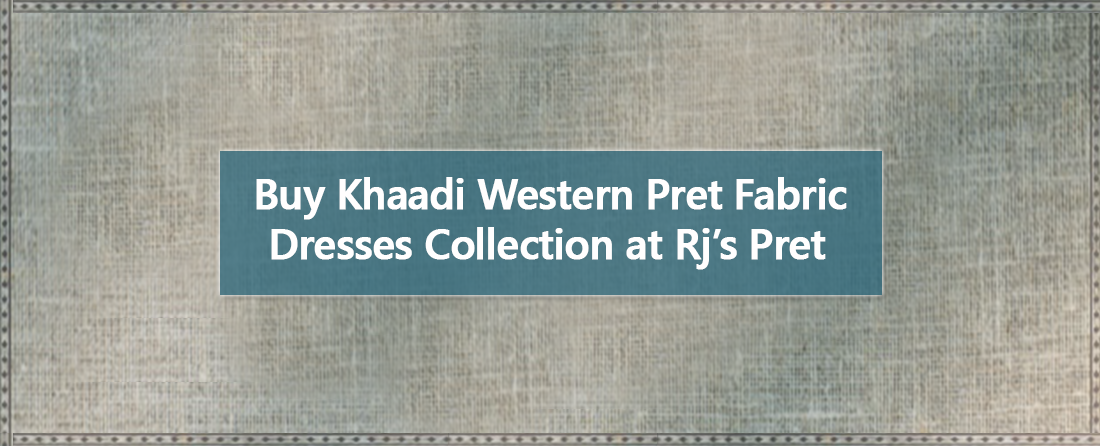Khaadi Lawn 2020 Pret History and Modern dresses evolution overview
Introduction:
Khadi fabric has evolved as the newest style trend since 1991 in India. When it is around the Origin of Khadi Textile its right Khadi came in Rjs Pret as a pure hand weaved native clothing material through the Swadeshi movement led by Mahatma Gandhi jee. But, khadi cloth has been created way before that in ancient development. Sure, it is right. Few of us identify the origin of khadi textiles. Khadi has started a lot before the Mahatma Gandhi Khadi movement.
Here at RJs Pret, I have discussed unheard information related to Khaadi Lawn 2020 Pret fabric which is a Pakistani well-known fabric.
History of Khadi Fabric- Khaadi Lawn 2020 Pret:
Along with holding an important historical occasion of the past, as well as famous current demand in the style industry and Pakistan handloom industry Khadi Textile, has a fascinating history regarding its foundation. The word ‘Khadi’ is created from ‘Khaddar’ which refers to the handspun cloth.
This 'Khaddar' term is also well known in Pakistan and the UK. Khadi is a kind of handspun and handwoven fabric commonly made from cotton fiber. On the other side, Khaadi lawn 2020 pret is also combined with cotton or wool and called khadi cotton or khaadi pret.
You will be shocked to know that numerous historians especially mentioned in the history of the ancient development Mohenjo-Daro discoursed regarding handwoven fabrics that are so alike to the quality of Khadi. This is because from several antique literary references historians had created the initial description of cotton fabrics in Pakistan. Greek historians Strabo had stated the soothing texture of UK fabric because, through the time of Alexandra’s invasion in other countries, the Greek army wore cotton attires which were far comfier during the summer season.
One of Alexander's aspirants remarked these cloth materials are made from fiber grown on the plants.
Deliberating? There's new. Khadi had a special recognition and attractiveness in the Maryann Era. In Chanukah’s ''Arthastra" he mentioned ‘Sutradh yaksha’ that mentions a person who is an expert in manufacturing yarn spun out of fabric, fiber hemp, bark-fiber, flax. In that time numerous expert artists were making cotton fabric and that had a pure quality and key role in that current economy.
That's why Mahatma Gandhi jee brought back Khadi as an innovative subcontinent product through the Swadeshi movement.
In the caverns of Ajanta, the pictures of the procedure of separating cotton threads from kernels have been created along with some descriptions of ladies spinning cotton yarns. Alexander and his successors introduce Indian cotton in the UK and Europe. So cotton has gained worldwide recognition meanwhile the antique era.
Today Khaadi Lawn 2020 Pret Fabric:
Not khaadi lawn 2020 pret factual but the handwoven fabric was well known in the early times, in the Mughal empire handwoven cloths used to be very famous especially the Muslin textile.
Despite having such a wonderful history after the growing popularity of textile mills and cheap clothes produced by these, they grabbed the Indian markets and as a result, the handwoven fabric was facing a big loss. But Gandhi had revived the Khadi industry and hand-spun products during the Swadeshi movement.
It is factual and has a special texture. The reason why khaadi western pret is so famous and popular even amongst celebrities and officials is because of its rough texture and it feels very comfy in summer and warm in the winter season.
Fascinatingly, antique temples in fabric industries give a varied and brief account of the ranges of outfits worn by native Pakistani.
Each temple in Pakistan from varied regions reflects distinct factual ranges and fabric traditions. The material khans are manufactured by sustaining a specific length and size. Ladies from parts of Marathwada, Vidarbha region from Maharashtra, northern Karnataka create usage of Gulegagud Khanna.
The embellishing art of clothing has been an age-old traditional norm and method from the historical past.
Pakistani handloom textiles have abounded kinds of costumes, though, saris and shirts have special import. Saris are strongly well-known to Pakistani ladies. Art and design have shown strong modern and sentimental importance to the sari and shirt also starred as one of the most stunning clothes in the world.
The Pakistan industry not only reflects ranges in clothes but also reflects on wearing and knitting elegance. A big number of folk thrive on the connoisseurs of art and plaiting.
Colonial times had endangered the textiles, weakening the weavers and artists in Pakistan. Most of the manufacturing during the Colonial time used to ship to the UK, H.Q. of the British Empire. The Victoria and Albert Museum still exhibits the Clothes of Pakistan, charting Pakistan textile. The exhibition in the industry presents several stages in the cotton fabric made according to Handloom Manufacturing. Colonial British law had destroyed the designer and creative workers in the subcontinent handloom industry by introducing raw materials back to their nation to create finished goods.
The finished goods were transported back to the subcontinent and sold at a higher rate, the cash used to go back to the UK. Mahatma Gandhi started the Swadeshi association whereby knitting and complete attire manufacturing was reinstated in the subcontinent. It was only after the British rule ended and Pakistan became independent that the Khadi textiles regained its position. The fabric industry creation post-independence was primarily dependent upon slight scale weavers and producers creating traditional attires.
Conclusion:
Weaving in antique Pakistan was conducted in lengths and ranges of the other country as urban, rural industry and semi-urban environments. Hand knitting is worn by famous personalities of Pakistan, and artists, designers, and weavers working a prominent position in courts of UK king palaces. This kind of textiles has been spread through numerous states of other countries. The state of Karnataka has a customary design and elaborate weaving techniques.
Alkali saris of Bagalkot and Molakalmuru sarees of Chitradurga and includes the customary saris of Karnataka. The weaving of Alkali dates back to the 10th century AD has still remained famous. In Maharashtra and Karnataka regions, the modern clusters of Vidarbha, Maratha Wada, and Gielgud Kanawha are very well-known. Likewise, in West Bengal, the increase of handloom cotton textiles, khadi, and Dhaka has been worn customarily by ladies.
Meanwhile, the Khaadi Lawn 2020 Pret became extensively popular among native Pakistani people. Pure Khaadi silk pret outfits are available at Rjs Pret online store.

